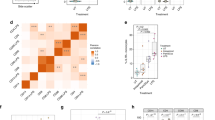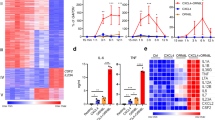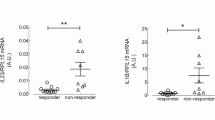Abstract
Innate immune cells, such as monocytes, can adopt a long-lasting pro-inflammatory phenotype, a phenomenon called ‘trained immunity’. In trained immunity, increased cytokine levels of genes, like interleukin (IL)-6 and tumor necrosis factor (TNF)-α, are observed, which are associated with increased histone 3 lysine 4 trimethylation (H3K4me3) in the promoter region. As systemic IL6 and TNFα levels are increased in rheumatoid arthritis (RA) patients and monocytes are known to be the primary producers of TNFα and IL6, we hypothesized that ‘trained immunity’ signals may be observed at these genes in monocytes from RA patients. CD14+ monocytes were isolated from untreated RA patients and paired age-matched healthy controls. H3K4me3, mRNA, protein and serum levels of IL6 and TNFα were evaluated by chromatin immunoprecipitation, reverse-transcription quantitative PCR and enzyme-linked immunosorbent assays. Despite elevated serum levels of TNFα and IL6 in the tested RA patients (P<0.05), ex vivo isolated monocytes displayed similar H3K4me3 levels to healthy controls in the promoter region of TNFα and IL6. Concordantly, mRNA and protein levels of IL6 and TNFα were similar before and after lipopolysaccharide stimulation between patients and controls. Together, with the current number of individuals tested we have not detected enhanced trained immunity signals in circulating monocytes from untreated RA patients, despite increased IL6 and TNFα serum levels.
This is a preview of subscription content, access via your institution
Access options
Subscribe to this journal
Receive 6 digital issues and online access to articles
$119.00 per year
only $19.83 per issue
Buy this article
- Purchase on Springer Link
- Instant access to full article PDF
Prices may be subject to local taxes which are calculated during checkout



Similar content being viewed by others
References
Messemaker TC, Huizinga TW, Kurreeman F . Immunogenetics of rheumatoid arthritis: Understanding functional implications. J Autoimmun 2015; 64: 7–14.
Viatte S, Plant D, Raychaudhuri S . Genetics and epigenetics of rheumatoid arthritis. Nat Rev Rheumatol 2013; 9: 141–153.
Jirtle RL, Skinner MK . Environmental epigenomics and disease susceptibility. Nat Rev Genet 2007; 8: 253–262.
Ballestar E . Epigenetics lessons from twins: prospects for autoimmune disease. Clin Rev Allergy Immunol 2010; 39: 30–41.
Peschansky VJ, Wahlestedt C . Non-coding RNAs as direct and indirect modulators of epigenetic regulation. Epigenetics 2014; 9: 3–12.
Quintin J, Saeed S, Martens JHa, Giamarellos-Bourboulis EJ, Ifrim DC, Logie C et al. Candida albicans infection affords protection against reinfection via functional reprogramming of monocytes. Cell Host Microbe 2012; 12: 223–232.
Netea MG, Joosten LaB, Latz E, Mills KHG, Natoli G, Stunnenberg HG et al. Trained immunity: a program of innate immune memory in health and disease. Science 2016; 352: aaf1098.
Wei S-T, Sun Y-H, Zong S-H, Xiang Y-B . Serum levels of IL-6 and TNF-α may correlate with activity and severity of rheumatoid arthritis. Med Sci Monit 2015; 21: 4030–4038.
Xu S . TNF inhibitor therapy for rheumatoid arthritis. Biomed Rep 2012; 1: 177–184.
Agarwal S, Piesco NP, Johnst LP, Riccellit AE . Differential expression of IL-113, TNF-ox, IL-6, and IL-8 in human monocytes in response to lipopolysaccharides from different microbes. J Dent Res 2016; 74: 1057–1065.
Houssiau FA, Devogelaer JP, J Van Damme, CN de Deuxchaisnes, Van Snick J . Interleukin-6 in synovial fluid and serum of patients with rheumatoid arthritis and other inflammatory arthritides. Arthritis Rheum 1988; 31: 784–788.
Tetta C, Camussi G, Modena V, Vittorio CDi, Baglioni C . Tumour necrosis factor in serum and synovial fluid of patients with active and severe rheumatoid arthritis. Ann Rheum Dis 1990; 49: 665–667.
Srirangan S, Choy EH . The role of interleukin 6 in the pathophysiology of rheumatoid arthritis. Ther Adv Musculoskelet Dis 2010; 2: 247–256.
Woodrick R, Ruderman EM . Anti-interleukin-6 therapy in rheumatoid arthritis. Bull NYU Hosp Jt Dis 2010: 68 211–217.
Vasanthi P, Nalini G, Rajasekhar G . Role of tumor necrosis factor-alpha in rheumatoid arthritis : a review. Int J Rheum Dis 2007; 10: 270–274.
Greer EL, Shi Y . Histone methylation: a dynamic mark in health, disease and inheritance. Nat Rev Genet 2012; 13: 343–357.
Klein K, Ospelt C, Gay S . Epigenetic contributions in the development of rheumatoid arthritis. Arthritis Res Ther 2012; 14: 227.
Karouzakis E, Gay RE, Michel Ba, Gay S, Neidhart M . DNA hypomethylation in rheumatoid arthritis synovial fibroblasts. Arthritis Rheum 2009; 60: 3613–3622.
Nile CJ, Read RC, Akil M, Duff GW, Wilson AG . Methylation status of a single CpG site in the IL6 promoter is related to IL6 messenger RNA levels and rheumatoid arthritis. Arthritis Rheum 2008; 58: 2686–2693.
Liao J, Liang G, Xie S, Zhao H, Zuo X, Li F et al. CD40L demethylation in CD4(+) T cells from women with rheumatoid arthritis. Clin Immunol 2012; 145: 13–18.
Trenkmann M, Brock M, Gay RE, Kolling C, Speich R, Michel BA et al. Expression and function of EZH2 in synovial fibroblasts: epigenetic repression of the Wnt inhibitor SFRP1 in rheumatoid arthritis. Ann Rheum Dis 2011; 70: 1482–1488.
McInnes IB, Schett G . Cytokines in the pathogenesis of rheumatoid arthritis. Nat Rev Immunol 2007; 7: 429–442.
Saeed S, Quintin J, Kerstens HHD, Rao Na, Aghajanirefah A, Matarese F et al. Epigenetic programming of monocyte-to-macrophage differentiation and trained innate immunity. Science 2014; 345: 1251086.
Kaikkonen MU, Spann NJ, Heinz S, Romanoski CE, Allison Ka, Stender JD et al. Remodeling of the enhancer landscape during macrophage activation is coupled to enhancer transcription. Mol Cell 2013; 51: 310–325.
Ostuni R, Piccolo V, Barozzi I, Polletti S, Termanini A, Bonifacio S et al. Latent enhancers activated by stimulation in differentiated cells. Cell 2013; 152: 157–171.
Zhang Z, Zhang R . Epigenetics in autoimmune diseases: pathogenesis and prospects for therapy. Autoimmun Rev 2015; 14: 854–863.
Gillespie J, Savic S, Wong C, Hempshall A, Inman M, Emery P et al. Histone deacetylases are dysregulated in rheumatoid arthritis and a novel histone deacetylase 3-selective inhibitor reduces interleukin-6 production by peripheral blood mononuclear cells from rheumatoid arthritis patients. Arthritis Rheum 2012; 64: 418–422.
Arnett FC, Edworthy SM, Bloch DA, McShane DJ, Fries JF, Cooper NS et al. The American Rheumatism Association 1987 revised criteria for the classification of rheumatoid arthritis. Arthritis Rheum 1988; 31: 315–324.
Messemaker TC, Frank-Bertoncelj M, Marques RB, Adriaans A, Bakker AM, Daha N et al. A novel long non-coding RNA in the rheumatoid arthritis risk locus TRAF1-C5 influences C5 mRNA levels. Genes Immun 2016; 17: 85–92.
Livak KJ, Schmittgen TD . Analysis of relative gene expression data using real-time quantitative PCR and the 2(-Delta Delta C(T)) Method. Methods 2001; 25: 402–408.
Acknowledgements
We are grateful for the RA patients and the healthy volunteers for donating blood. This work was supported by the Dutch Arthritis Foundation, The Netherlands. FK has support from UNESCO-L’Oreal for Women in Science Fellowship, Marie Curie FP7 Outgoing Fellowship and an LUMC Research Fellowship. The work of VdH-vM was supported by a Vidi-grant of the Dutch Organisation for Scientific Research.
Author information
Authors and Affiliations
Corresponding author
Ethics declarations
Competing interests
The authors declare no conflict of interest.
Additional information
Supplementary Information accompanies this paper on Genes and Immunity website
Supplementary information
Rights and permissions
About this article
Cite this article
Messemaker, T., Mikkers, H., Huizinga, T. et al. Inflammatory genes TNFα and IL6 display no signs of increased H3K4me3 in circulating monocytes from untreated rheumatoid arthritis patients. Genes Immun 18, 191–196 (2017). https://doi.org/10.1038/gene.2017.20
Received:
Revised:
Accepted:
Published:
Issue Date:
DOI: https://doi.org/10.1038/gene.2017.20
This article is cited by
-
Serum level of total histone 3, H3K4me3, and H3K27ac after non-emergent cardiac surgery suggests the persistence of smoldering inflammation at 3 months in an adult population
Clinical Epigenetics (2022)
-
Cell death pathologies: targeting death pathways and the immune system for cancer therapy
Genes & Immunity (2019)



